seats KIA K900 2015 1.G Owner's Manual
[x] Cancel search | Manufacturer: KIA, Model Year: 2015, Model line: K900, Model: KIA K900 2015 1.GPages: 522, PDF Size: 7.92 MB
Page 20 of 522
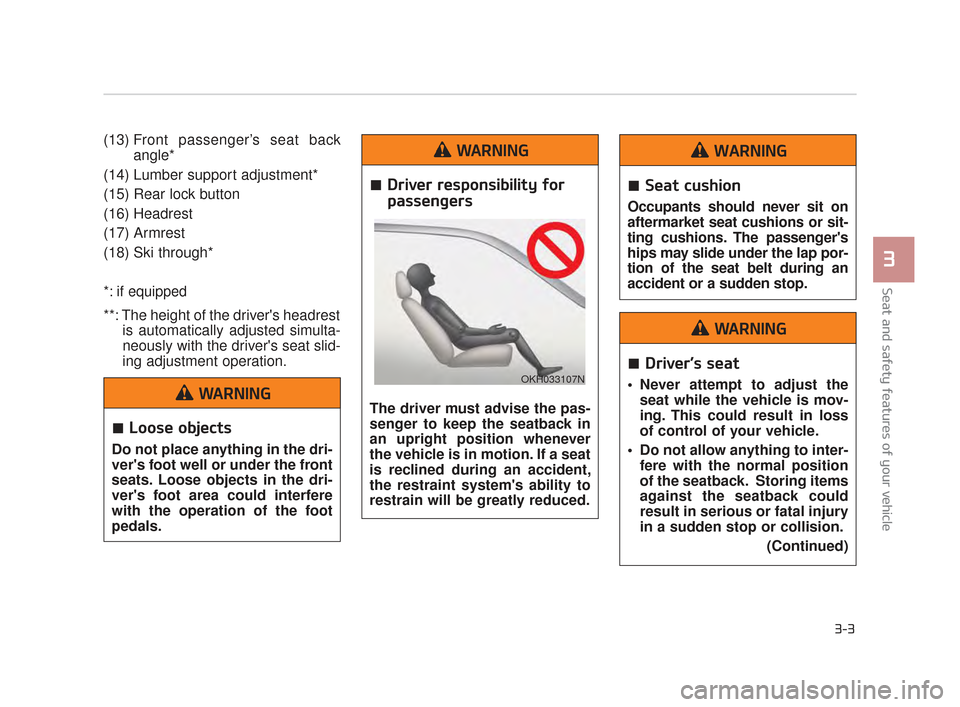
Seat and safety features of your vehicle
3
3-3
(13) Front passenger’s seat backangle*
(14) Lumber support adjustment*
(15) Rear lock button
(16) Headrest
(17) Armrest
(18) Ski through*
*: if equipped
**: The height of the driver's headrest is automatically adjusted simulta-
neously with the driver's seat slid-
ing adjustment operation.
Loose objects
Do not place anything in the dri-
ver's foot well or under the front
seats. Loose objects in the dri-
ver's foot area could interfere
with the operation of the foot
pedals.
WARNING
Driver responsibility for
passengers
The driver must advise the pas-
senger to keep the seatback in
an upright position whenever
the vehicle is in motion. If a seat
is reclined during an accident,
the restraint system's ability to
restrain will be greatly reduced.
WARNING
OKH033107N
Seat cushion
Occupants should never sit on
aftermarket seat cushions or sit-
ting cushions. The passenger's
hips may slide under the lap por-
tion of the seat belt during an
accident or a sudden stop.
WARNING
Driver’s seat
Never attempt to adjust theseat while the vehicle is mov-
ing. This could result in loss
of control of your vehicle.
Do not allow anything to inter- fere with the normal position
of the seatback. Storing items
against the seatback could
result in serious or fatal injury
in a sudden stop or collision.
(Continued)
WARNING
KH CAN (ENG) 3:2015 3/26/2015 6:06 AM Page 3
Page 21 of 522
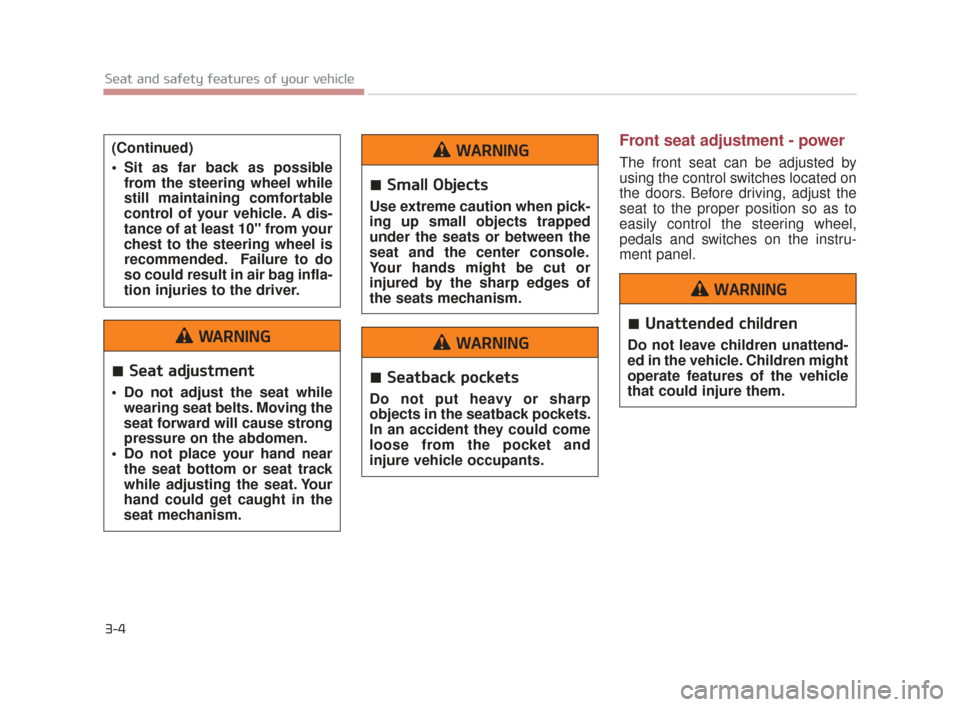
Front seat adjustment - power
The front seat can be adjusted by
using the control switches located on
the doors. Before driving, adjust the
seat to the proper position so as to
easily control the steering wheel,
pedals and switches on the instru-
ment panel.
3-4
Seat and safety features of your vehicle
(Continued)
Sit as far back as possiblefrom the steering wheel while
still maintaining comfortable
control of your vehicle. A dis-
tance of at least 10" from your
chest to the steering wheel is
recommended. Failure to do
so could result in air bag infla-
tion injuries to the driver.
Seat adjustment
Do not adjust the seat whilewearing seat belts. Moving the
seat forward will cause strong
pressure on the abdomen.
Do not place your hand near the seat bottom or seat track
while adjusting the seat. Your
hand could get caught in the
seat mechanism.
WARNINGUnattended children
Do not leave children unattend-
ed in the vehicle. Children might
operate features of the vehicle
that could injure them.
WARNING
Small Objects
Use extreme caution when pick-
ing up small objects trapped
under the seats or between the
seat and the center console.
Your hands might be cut or
injured by the sharp edges of
the seats mechanism.
WARNING
Seatback pockets
Do not put heavy or sharp
objects in the seatback pockets.
In an accident they could come
loose from the pocket and
injure vehicle occupants.
WARNING
KH CAN (ENG) 3:2015 3/26/2015 6:06 AM Page 4
Page 25 of 522

3-8
Seat and safety features of your vehicle
Recalling positions from memory
1.Check that the shift lever is in P(Park) and the Engine Start/Stop
Button is in the ON position.
2.To recall the position in memory, press the desired memory button
(1 or 2). The system will beep
once, then the driver seat, outside
rearview mirror and steering wheel
will automatically adjust to the
stored positions.
Adjusting the control switch for the
driver seat while the system is recall-
ing the stored position will cause the
movement to stop and move in the
direction that the control switch is
moved.
Use caution when recalling adjust-
ment memory while sitting in the
vehicle. Push the seat position con-
trol switch to the desired position
immediately if the seat moves too far
in any direction.Easy access function
When exiting the vehicle, the steer-
ing wheel will move away from the
driver and the seat will move rear-
ward when the engine is turned off.
When entering the vehicle, the steer-
ing wheel will move toward the driver
and the seat will move forward when
the Engine Start/Stop Button is
pressed to the ACC position or START
position.
You can activate or deactivate this
feature. Refer to "User settings" in
chapter 4.
Headrest (for front seat)
The driver's and front passenger's
seats are equipped with a headrest
for the occupant's safety and com-
for t.
The headrest not only provides com-
fort for the driver and front passen-
ger, but also helps protect the head
and neck in the event of a collision.
OKH033109N
KH CAN (ENG) 3:2015 3/26/2015 6:07 AM Page 8
Page 30 of 522

Rear seat adjustment
- for power seat (if equipped)
The rear seat can be adjusted by
using the control switches located on
the door.When in operation, the power seat
consumes a large amount of electri-
cal power. To prevent unnecessary
battery drain, don’t adjust the power
seat longer than necessary while the
engine is not running.
Seat and safety features of your vehicle
3
3-13
The power seat is operable with
the Engine Start/Stop Button in
OFF.
Therefore, children should never
be left unattended in the vehicle.
WARNING
Seat adjustment
Do not adjust the seat whilewearing seat belts. Moving the
seat forward will cause strong
pressure on the abdomen.
Do not place your hand near the seat when adjusting the
seat. Your hand could get
caught in the seat mecha-
nism.
WARNING
Do not operate the rear power
seat while the child seat is
installed. Operation of the rear
power seats affect the proper
car seat installation and thereby
increase the risk of injury to the
child seat occupant.
WARNING
Power seat adjustments
The power seating controls
function by electronic motor.
Excessive operation may cause
damage to the electrical equip-
ment.
CAUTION
Power Seating
Do not operate two or more
power seat control switches at
the same time. Doing so may
damage the power seat motor
or electrical components.
CAUTION
KH CAN (ENG) 3:2015 3/26/2015 6:07 AM Page 13
Page 31 of 522
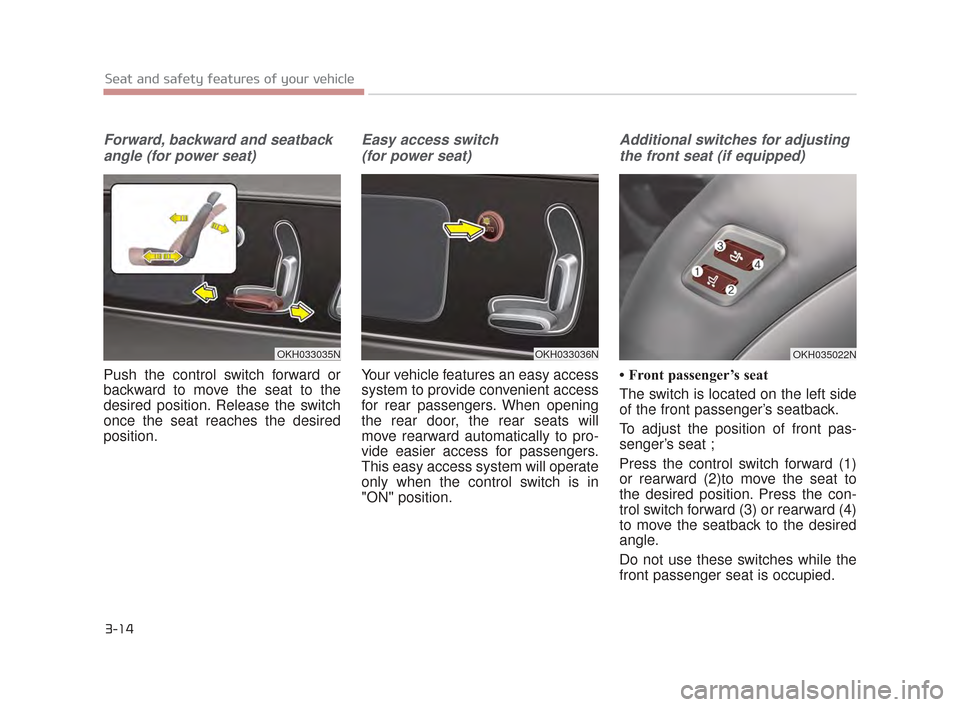
Forward, backward and seatbackangle (for power seat)
Push the control switch forward or
backward to move the seat to the
desired position. Release the switch
once the seat reaches the desired
position.
Easy access switch (for power seat)
Your vehicle features an easy access
system to provide convenient access
for rear passengers. When opening
the rear door, the rear seats will
move rearward automatically to pro-
vide easier access for passengers.
This easy access system will operate
only when the control switch is in
"ON" position.
Additional switches for adjustingthe front seat (if equipped)
• Front passenger’s seat
The switch is located on the left side
of the front passenger’s seatback.
To adjust the position of front pas-
senger’s seat ;
Press the control switch forward (1)
or rearward (2)to move the seat to
the desired position. Press the con-
trol switch forward (3) or rearward (4)
to move the seatback to the desired
angle.
Do not use these switches while the
front passenger seat is occupied.
3-14
Seat and safety features of your vehicle
OKH033035NOKH033036NOKH035022N
KH CAN (ENG) 3:2015 3/26/2015 6:07 AM Page 14
Page 36 of 522

Seat and safety features of your vehicle
3
3-19
Armrest
To use the armrest, pull it forward
from the seatback.
Carrying long / narrow cargo (for fixed seat, if equipped)
Additional cargo space is provided to
accommodate long/narrow cargo
(skis, poles, etc.) not able to fit prop-
erly in the trunk when closed.
1.Pull the armrest down.
2.Pull the cover down while pushing the release lever down.
OKH033027N
OKH033076N
Be careful when loadingcargo through the rear passen-
ger seats to prevent damage to
the vehicle interior.
When cargo is loaded through the rear passenger seats,
ensure the cargo is properly
secured to prevent it from mov-
ing while driving. Unsecured
cargo in the passenger com-
partment can cause damage to
the vehicle.
CAUTION
Cargo
Cargo should always be
secured to prevent it from being
thrown about the vehicle in a
collision and causing injury to
the vehicle occupants. Do not
place objects on the rear seats,
since they cannot be properly
secured and may hit the front
seat occupants in a collision.
WARNING
KH CAN (ENG) 3:2015 3/26/2015 6:07 AM Page 19
Page 46 of 522

Seat and safety features of your vehicle
3
3-29
The pre-safe seat belt warning light
will illuminate if there is a problem
with your pre-safe seat belt.
Have the system checked if:
The light does not turn on brieflywhen you turn the engine
start/stop button to the ON posi-
tion.
The light stays on after illumination for approximately 3 seconds.
The light comes on while the vehi- cle is in motion. The pre-safe seat belt system oper-
ates as below
The seat belt is tightened when:
- The vehicle senses a collision
- Emergency braking situationoccurs
- Loss of vehicle control
The seat belt vibrates when: - The vehicle detects and object tooclose to the vehicle
Other function is winding a loose
seat belt after unfastening seatbelt.
Seat belt precautions
Infant or small child
You should be aware of the specific
requirements in your country. Child
and/or infant seats must be properly
placed and installed in the rear seat.
For more information about the use
of these restraints, refer to “Child
restraint system” in this chapter.
OKH045515N
■ Type A■Type B
Do not be surprised when the
seat belt vibrates. It’s not a mal-
function but a warning for your
safety.
CAUTION
KH CAN (ENG) 3:2015 3/26/2015 6:08 AM Page 29
Page 48 of 522

Seat and safety features of your vehicle
3
3-31
Injured person
A seat belt should be used when an
injured person is being transported.
When this is necessary, you should
consult a physician for recommenda-
tions.
One person per belt
Two people (including children)
should never attempt to use a single
seat belt. This could increase the
severity of injuries in case of an acci-
dent.
Do not lie down
To reduce the chance of injuries in the
event of an accident and to achieve
maximum effectiveness of the
restraint system, all passengers
should be sitting up and the front
seats should be in an upright position
when the vehicle is moving. A seat
belt cannot provide proper protection
if the person is lying down in the rear
seat or if the front seat is in a reclined
position.
Care of seat belts
Seat belt systems should never be
disassembled or modified. In addi-
tion, care should be taken to assure
that seat belts and belt hardware are
not damaged by seat hinges, doors
or other abuse.
Periodic inspection
All seat belts should be inspected
periodically for wear or damage of
any kind. Any damaged parts should
be replaced as soon as possible.
Keep belts clean and dry
Seat belts should be kept clean and
dry. If belts become dirty, they can be
cleaned by using a mild soap solu-
tion and warm water. Bleach, dye,
strong detergents or abrasives
should not be used because they
may damage and weaken the fabric.
When to replace seat belts
The entire in-use seat belt assembly
or assemblies should be replaced if
the vehicle has been involved in an
accident. This should be done even if
no damage is visible. Additional
questions concerning seat belt oper-
ation should be directed to an
authorized Kia Premium dealer.
Pinched Seat belts
Make sure that the webbing
and/or buckle does not get
caught or pinched in the rear
seat when returning the rear
seatback to its upright position.
A caught or pinched webbing
/buckle may become damaged
and could fail during a collision
or sudden stop.
WARNING
KH CAN (ENG) 3:2015 3/26/2015 6:08 AM Page 31
Page 49 of 522
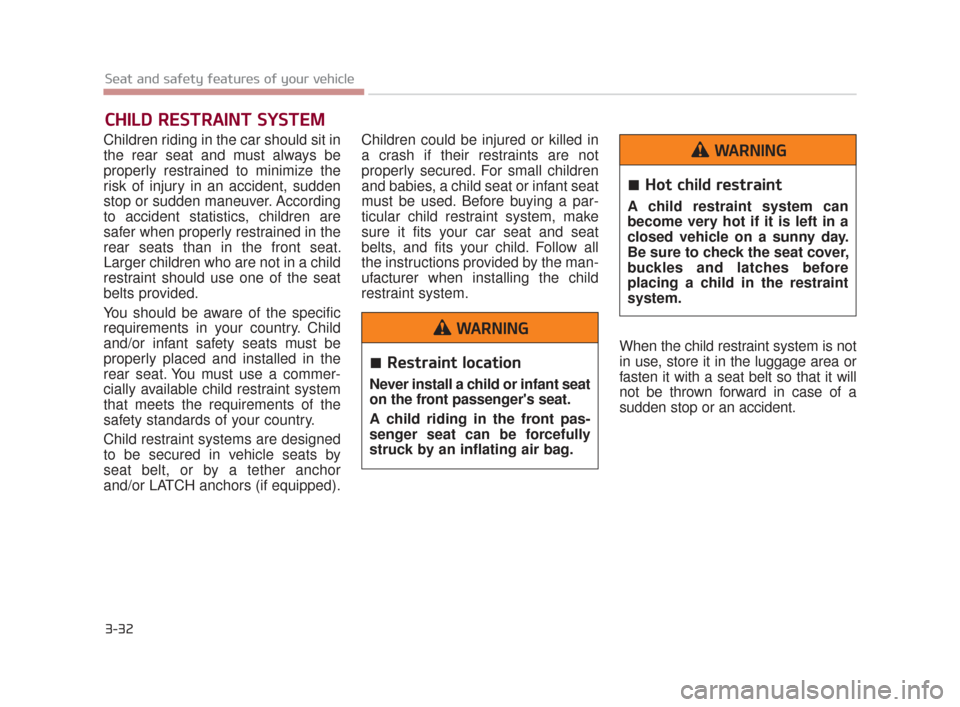
3-32
Seat and safety features of your vehicle
CHILD RESTRAINT SYSTEM
Children riding in the car should sit in
the rear seat and must always be
properly restrained to minimize the
risk of injury in an accident, sudden
stop or sudden maneuver. According
to accident statistics, children are
safer when properly restrained in the
rear seats than in the front seat.
Larger children who are not in a child
restraint should use one of the seat
belts provided.
You should be aware of the specific
requirements in your country. Child
and/or infant safety seats must be
properly placed and installed in the
rear seat. You must use a commer-
cially available child restraint system
that meets the requirements of the
safety standards of your country.
Child restraint systems are designed
to be secured in vehicle seats by
seat belt, or by a tether anchor
and/or LATCH anchors (if equipped).Children could be injured or killed in
a crash if their restraints are not
properly secured. For small children
and babies, a child seat or infant seat
must be used. Before buying a par-
ticular child restraint system, make
sure it fits your car seat and seat
belts, and fits your child. Follow all
the instructions provided by the man-
ufacturer when installing the child
restraint system.
When the child restraint system is not
in use, store it in the luggage area or
fasten it with a seat belt so that it will
not be thrown forward in case of a
sudden stop or an accident.
Restraint location
Never install a child or infant seat
on the front passenger's seat.
A child riding in the front pas-
senger seat can be forcefully
struck by an inflating air bag.
WARNING
Hot child restraint
A child restraint system can
become very hot if it is left in a
closed vehicle on a sunny day.
Be sure to check the seat cover,
buckles and latches before
placing a child in the restraint
system.
WARNING
KH CAN (ENG) 3:2015 3/26/2015 6:08 AM Page 32
Page 50 of 522
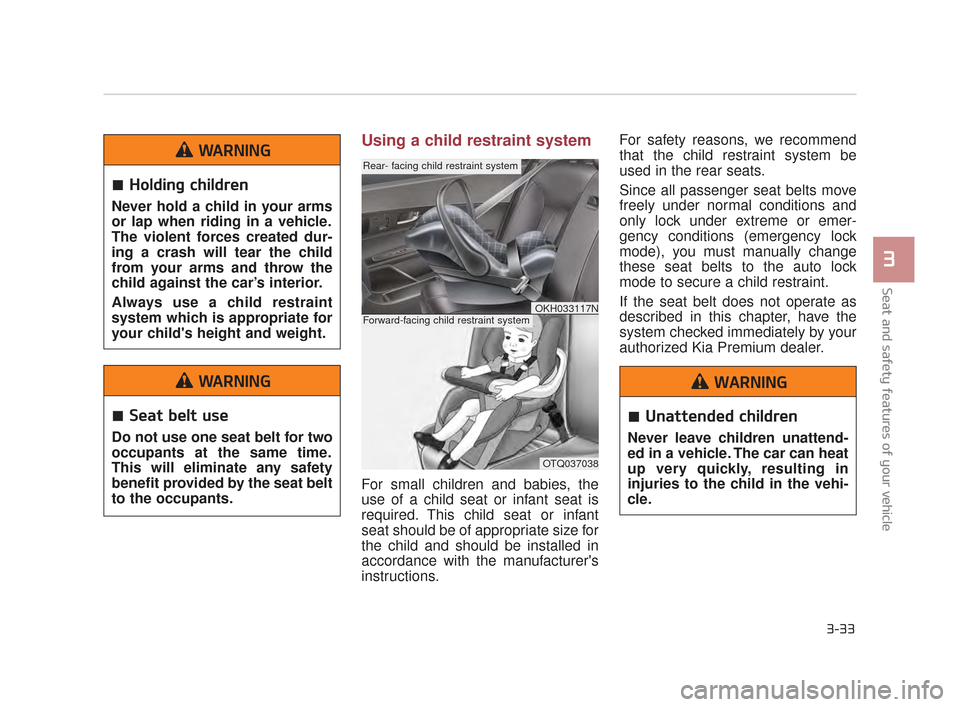
Seat and safety features of your vehicle
3
3-33
Using a child restraint system
For small children and babies, the
use of a child seat or infant seat is
required. This child seat or infant
seat should be of appropriate size for
the child and should be installed in
accordance with the manufacturer's
instructions. For safety reasons, we recommend
that the child restraint system be
used in the rear seats.
Since all passenger seat belts move
freely under normal conditions and
only lock under extreme or emer-
gency conditions (emergency lock
mode), you must manually change
these seat belts to the auto lock
mode to secure a child restraint.
If the seat belt does not operate as
described in this chapter, have the
system checked immediately by your
authorized Kia Premium dealer.
OTQ037038
Rear- facing child restraint system
Forward-facing child restraint systemOKH033117N
Holding children
Never hold a child in your arms
or lap when riding in a vehicle.
The violent forces created dur-
ing a crash will tear the child
from your arms and throw the
child against the car’s interior.
Always use a child restraint
system which is appropriate for
your child's height and weight.
WARNING
Seat belt use
Do not use one seat belt for two
occupants at the same time.
This will eliminate any safety
benefit provided by the seat belt
to the occupants.
WARNING
Unattended children
Never leave children unattend-
ed in a vehicle. The car can heat
up very quickly, resulting in
injuries to the child in the vehi-
cle.
WARNING
KH CAN (ENG) 3:2015 3/26/2015 6:08 AM Page 33